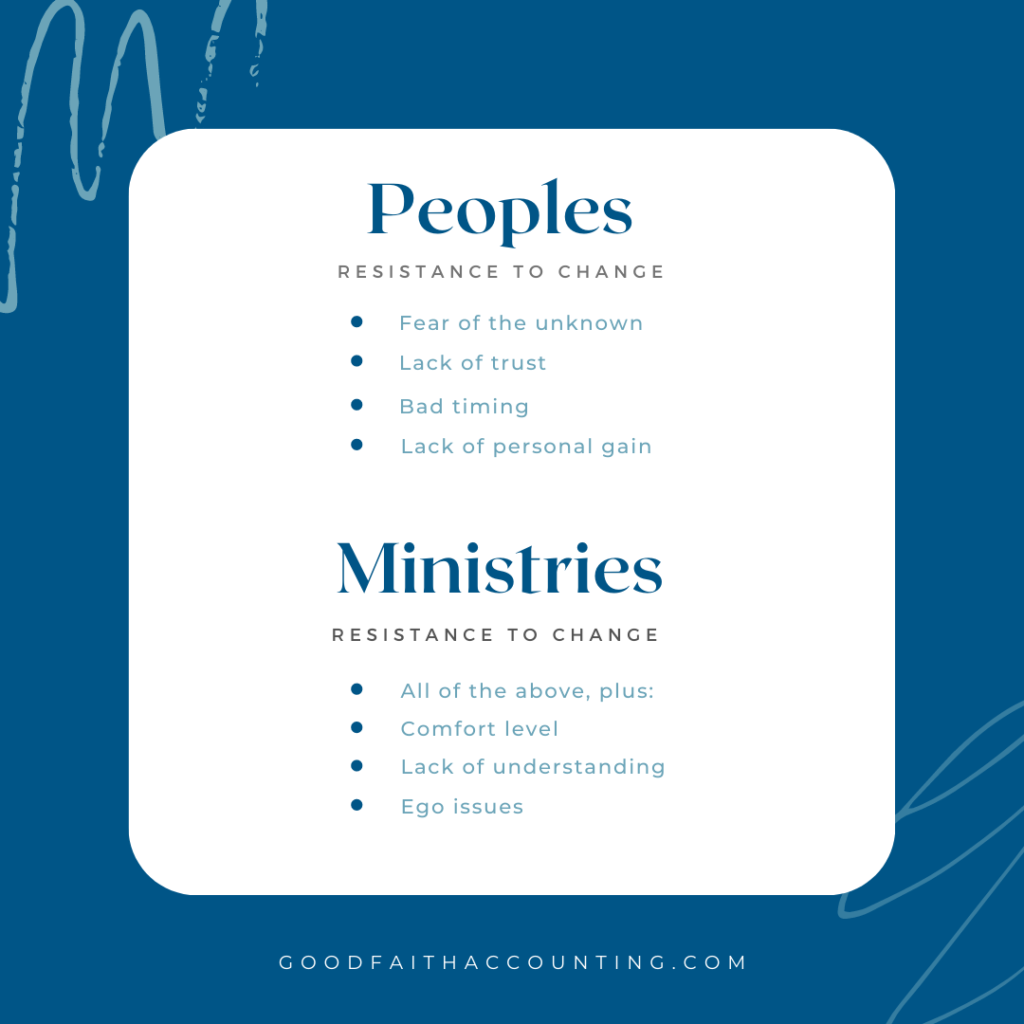September 22, 2021
Facilitating Effective Change in Your Ministry
Everyone loves change, right?
Change is great; you go first.
That seems to be most people’s mantra. Especially when “that’s the way we’ve always done it!” is the best argument one can come up with when faced with an opportunity to change.
Well, no more. You will be an effective agent of change by the time you’re done reading this post! Or, at least, on your way to being more effective. 
The following was taken from our training course on this subject. If you find that this area of change is something your church or nonprofit could benefit from hearing more about; Contact Us to schedule a training session.
Types of Change
First, let’s describe the three types of change. Minor. Major. Transformational. A minor change refers to a change within an existing system. A major change could be a new process. Lastly, the transformational change is usually multi-dimensional and multi-level.
For more on transformational change, view our Staff Transitions blog post
Managing the Resistance to Change
Now that we know the different types of change, let’s tackle why people might be resistant.
There are many reasons why people are resistant to change. Some studies have shown that it’s in our DNA; either we are born with a predisposed position against change, or it may even have something to do with our birth order! Some other reasons fall into the categories of:
- fear of the unknown
- lack of trust
- bad timing
- lack of personal gain
If we’re being honest, ministries often are resistant to change as well. Their reasoning may be the same as above; but could also be their comfort level, lack of understanding, or ego issues.

For the Leader
As the leader, it is your job to communicate with your team, celebrate the little wins, allow time to grieve the past, and be an example for how to move forward. While doing those things, you may find that adjustments to the plan are necessary. That’s all a part of the process.
Make sure you aren’t allowing yourself to be too rigid for change, that you lose sight of the benefits of the change.
Determine the biggest pain points, and devise a plan to address them. Here are our top 5 ways for the leader to plan for resistance to change:

- Ask questions.
- Acknowledge the issues.
- Empathize with your constituents.
- Devise a plan.
- Communicate.
Stages of Resistance to Change
Next, let’s focus on the areas of resistance: Denial. Resistance. Exploration. Commitment.
Those are all self explanatory stages, but that doesn’t make them easy to manage. Here are some of our effective solutions for leaders to incorporate into their teams when managing the resistance to change.
- Create an environment that can incorporate and encourage people regardless of what stage they are in.
- Realize that it takes longer for some to work through the various stages.
- After coaching them, give them time to respond.
- Be empathetic, but don’t allow them to stay in one stage too long. Help them move forward.
“Don’t fall into the trap of believing there’s such thing as a low-stress organization that’s on track to survive. In fact, just the opposite is true. You serve your best interests by aligning yourself with an outfit that’s got the guts to endure the pains of change, and by avoiding those organizations destined to go belly-up because of their desire for short-term comfort.”
A Survival Guide to the Stress of Organizational Change; Pritchett & Pound
Ensuring Effective Change in your Organization
As we mentioned above, this text was taken from our training course on this subject. If you find that this area of change is something your church or nonprofit could benefit from hearing more about, Contact Us to schedule a training session.
Not only do our experienced trainers go into much more detail; but there are worksheets, diagrams, book recommendations, and evaluations for team members to utilize to help facilitate group change when that time comes. What are you waiting for, you effective change agent, you?
Stay Connected